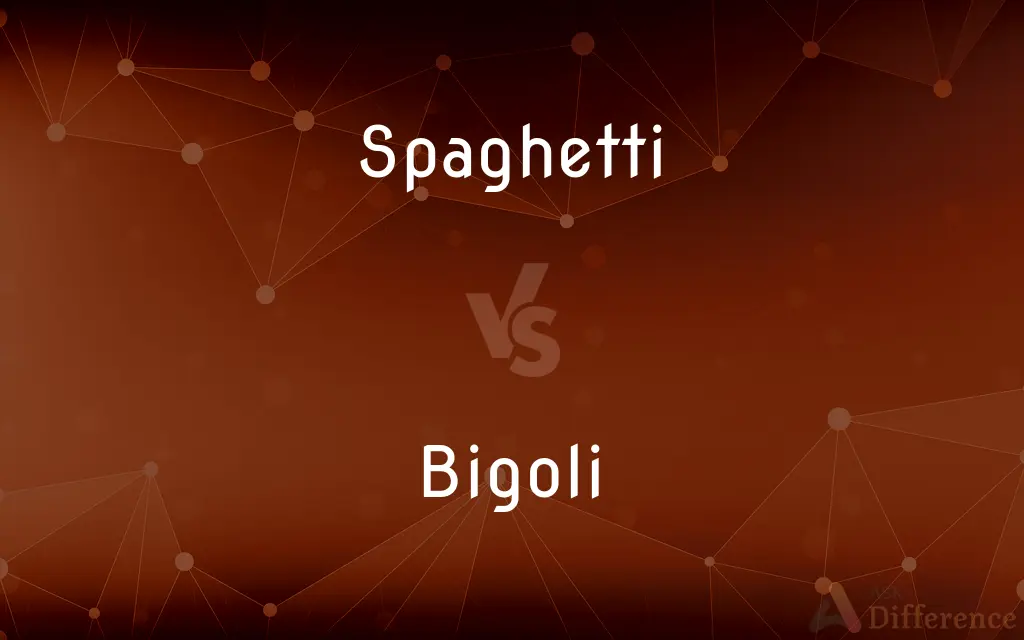Spaghetti vs. Bigoli — What's the Difference?
Edited by Tayyaba Rehman — By Maham Liaqat — Updated on March 9, 2024
Spaghetti is a thin, long, cylindrical pasta of Italian origin, known for its versatility in dishes. Bigoli is a thicker, more robust wheat pasta, often made with duck eggs, offering a denser texture and richer flavor.

Difference Between Spaghetti and Bigoli
Table of Contents
ADVERTISEMENT
Key Differences
Spaghetti, one of the most popular types of pasta worldwide, is recognized for its thin, long strands and is often made from durum wheat semolina. It pairs well with a variety of sauces, from light olive oil-based to hearty meat sauces. In contrast, bigoli, a traditional pasta from the Veneto region of Italy, is thicker and comes with a rougher texture. This difference in size and texture means that bigoli can hold onto sauces more robustly than the smoother and slimmer spaghetti.
While spaghetti is commonly used in a wide array of Italian and international dishes, bigoli has a more specific regional focus, often served with rich, hearty sauces that complement its dense texture. Whereas spaghetti can be quickly cooked and tossed with a sauce for a simple meal, bigoli may require more careful preparation and is typically paired with ingredients like game, duck, and seasonal vegetables.
The preparation process also distinguishes these pastas; traditional spaghetti is extruded through a machine to achieve its uniform shape, while bigoli is traditionally made using a bigolaro, a press that gives it a unique texture. On the other hand, modern versions of bigoli might be made with more accessible pasta machines but still aim to retain that distinctive thick and rough texture.
Nutritionally, both pastas offer similar benefits, being good sources of carbohydrates; however, bigoli's use of whole eggs or duck eggs in the dough adds a higher protein content and a richer flavor profile compared to the more neutral taste of spaghetti. This ingredient difference subtly influences the nutritional value and culinary uses of each pasta type.
Culturally, spaghetti has achieved global fame, becoming synonymous with Italian cuisine in the international imagination. Bigoli, however, remains a cherished example of Italy's diverse regional culinary traditions, offering a taste of Veneto's rich history and flavor preferences.
ADVERTISEMENT
Comparison Chart
Thickness
Thin and cylindrical
Thicker and denser
Texture
Smooth
Rougher, holds onto sauces better
Regional Origin
Italy (widespread)
Veneto region, Italy
Common Ingredients
Durum wheat semolina
Wheat, often with duck eggs
Flavor
Neutral, versatile with many sauces
Richer, often paired with hearty sauces
Preparation Tool
Pasta machine or extruder
Bigolaro (traditional press) or pasta machine
Nutritional Content
Carbohydrates with some protein
Higher protein content due to eggs, carbohydrates
Culinary Uses
Versatile, suits a wide range of sauces
Best with robust, rich sauces like those with game or duck
Global Popularity
Extremely popular internationally
More niche, appreciated within Italian regional cuisine
Compare with Definitions
Spaghetti
A thin, long pasta ideal for a variety of sauces.
Spaghetti with marinara sauce is a classic Italian dish.
Bigoli
A thicker, denser pasta traditionally made with duck eggs.
The bigoli's rich flavor was enhanced by the duck ragù.
Spaghetti
Made from durum wheat for a smooth texture.
The spaghetti's smooth texture made it perfect for the light garlic and oil sauce.
Bigoli
Originates from Veneto, offering a taste of regional Italy.
Bigoli in salsa, anchovy and onion sauce, is a Venetian specialty.
Spaghetti
A staple in Italian and international cuisine.
Spaghetti and meatballs have become an iconic dish worldwide.
Bigoli
Requires a specific press for its unique texture.
Making bigoli at home with a traditional bigolaro adds to its authenticity.
Spaghetti
Recognized for its quick cooking time.
Spaghetti is my go-to for a fast and satisfying meal.
Bigoli
Best paired with hearty, robust sauces.
The bigoli's dense texture held the wild boar sauce beautifully.
Spaghetti
Easily adaptable to both light and hearty dishes.
Whether tossed in a pesto or a meat sauce, spaghetti always delivers.
Bigoli
Enriches the dish with its substantial bite and flavor.
The bigoli provided a satisfyingly chewy contrast to the delicate vegetables.
Spaghetti
Spaghetti (Italian: [spaˈɡetti]) is a long, thin, solid, cylindrical pasta. It is a staple food of traditional Italian cuisine.
Bigoli
Bigoli [ˈbiːɡoli] (Venetian: bìgołi) is an extruded pasta in the form of a long and thick strand. Initially bigoli were made with buckwheat flour, but are now more commonly made with whole wheat flour, and sometimes include duck eggs.
Spaghetti
Pasta made in solid strings, between macaroni and vermicelli in thickness.
Bigoli
A type of spaghetti, with a rough texture, from the Veneto.
Spaghetti
Pasta in long, often thick strands.
Spaghetti
(Electricity) A slender tube of insulating material that covers bare wire.
Spaghetti
A type of pasta made in the shape of long thin strings.
Spaghetti
(by extension) A dish that has spaghetti as a main part of it, such as spaghetti bolognese.
Spaghetti
(informal) Any type of pasta.
Spaghetti
(informal) Electrical insulating tubing.
Spaghetti
(informal) Anything tangled or confusing.
Spaghetti
(countable) A spaghetti western.
Spaghetti
Spaghetti code.
Spaghetti
To become, or appear to become longer and thinner.
The cables spaghettied onto the shoulder of the technician.
Spaghetti
To stretch to become longer and thinner.
He spaghettied the referee when he landed on him.
Spaghetti
A variety or macaroni made in tubes of small diameter.
Spaghetti
Pasta in the form of long strings
Common Curiosities
Can bigoli and spaghetti be used interchangeably in recipes?
While they can be substituted based on personal preference, their differing textures and thicknesses may affect the final dish's outcome.
How does the cooking time of spaghetti compare to bigoli?
Spaghetti typically has a shorter cooking time due to its thinner size, whereas bigoli, being thicker, may require a few extra minutes.
Are there any health benefits to choosing one pasta over the other?
The health benefits are similar, though bigoli's use of eggs can offer additional protein, making it slightly more nutritious.
Why is bigoli less known outside Italy compared to spaghetti?
Bigoli is a regional specialty with a stronger flavor and denser texture, making it less versatile than the universally appealing spaghetti.
What is the traditional way to serve bigoli?
Traditionally, bigoli is served with rich, hearty sauces such as duck ragù or the classic Venetian anchovy and onion sauce (bigoli in salsa).
What sauces pair well with spaghetti?
Spaghetti pairs well with a wide range of sauces, from light tomato to creamy alfredo and hearty meat sauces.
What's the main difference between spaghetti and bigoli?
The main difference lies in their thickness and texture, with bigoli being thicker and having a rougher texture than spaghetti.
What makes bigoli unique in flavor?
The inclusion of duck eggs in the dough adds a richness and depth of flavor not commonly found in other pasta types.
Can I make bigoli without a bigolaro?
Yes, modern pasta machines offer dies or attachments that can mimic the size and texture of bigoli, making it accessible to home cooks.
Is spaghetti or bigoli better for a specific occasion?
Spaghetti is versatile and suitable for various occasions, while bigoli may be preferred for more rustic, hearty meals.
Share Your Discovery

Previous Comparison
Fishnet vs. Mesh
Next Comparison
Inchon vs. IncheonAuthor Spotlight
Written by
Maham LiaqatEdited by
Tayyaba RehmanTayyaba Rehman is a distinguished writer, currently serving as a primary contributor to askdifference.com. As a researcher in semantics and etymology, Tayyaba's passion for the complexity of languages and their distinctions has found a perfect home on the platform. Tayyaba delves into the intricacies of language, distinguishing between commonly confused words and phrases, thereby providing clarity for readers worldwide.
















































